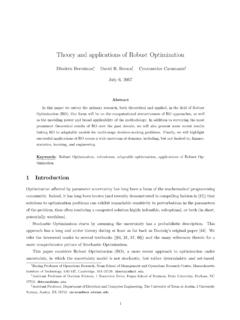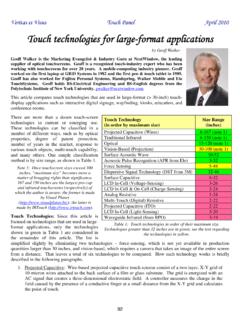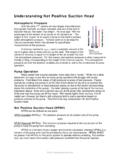Transcription of Biotechnology applications in food processing and …
1 January 2010 ABDC-10 E. FAO International Technical Conference Agricultural biotechnologies in developing countries: Options and opportunities in crops, forestry, livestock, fisheries and agro-industry to face the challenges of food insecurity and climate change (ABDC-10). Guadalajara, Mexico, 1 4 March 2010. Current status and options for biotechnologies in food processing and in food safety in developing countries Acknowledgments This background document is the result of the joint effort of many contributors. The initial key contributions were made by Olusola B. Oyewole from University of Agriculture, Abeokuta, Nigeria and Ruud Valyasevi from the National Center for Genetic Engineering and Biotechnology (Biotec), Biotec, Bangkok, Thailand.
2 Sections relevant to Biotechnology applications in food processing : Coordination was done by Rosa Rolle (Senior Agro-Industries and Post-harvest Officer, FAO Regional Office for Asia and the Pacific). who also made significant contributions to the document. Sections relevant to Biotechnology applications in food safety: Coordination was done by Masami Takeuchi ( food Safety Officer, Nutrition and Consumer Protection Division). Significant contributions were made by Sridhar Dharmapuri, FAO consultant. Technical contributions from several FAO colleagues, including Maria de Lourdes Costarrica (Senior officer, Nutrition and Consumer Protection Division) and Annika Wennberg (Senior Officer, FAO JECFA Secretariat, Nutrition and Consumer Protection Division), to the document are also gratefully acknowledged.
3 Comments from the following members of the ABDC-10 Steering Committee are gratefully acknowledged: Adama Diallo (Joint FAO/IAEA Division, Austria), Kathleen Jones (US food and Drug Administration, United States), Marci Levine (International Life Sciences Institute, United States), Haruko Okusu (CGIAR Science Council, Italy), Masashi Kusukawa (Codex Alimentarius Commission, Italy) and J rgen Schlundt (World Health Organization, Switzerland). Technical support and comments from John Ruane and Preet Lidder from the ABDC-10 Secretariat are also gratefully acknowledged This document is printed in limited numbers to minimize the environmental impact of FAO's processes and contribute to climate eutrality. Delegates and observers are kindly requested to bring their copies to meetings and to avoid asking for additional copies.
4 Most FAO meeting documents are available on the Internet at Table of Contents Acronyms and abbreviations A. Introduction B. Stocktaking - Learning from the Past 1. Biotechnology Definition and scope 2. Current status of the application of traditional and new biotechnologies in food processing in developing countries Methods of microbial inoculation in food fermentations food additives and processing aids Current status of the application of traditional and new biotechnologies in food safety and quality improvement in developing countries 3. Analysis of the reasons for successes/failures of application of biotechnologies in developing countries 4. Case studies of Biotechnology applications in developing countries Fermented soy sauce production Traditional fermented pork sausage (nham).
5 Traditional fermented fish paste Som Fug Flavour production from alkaline-fermented beans C. Looking Forward: Preparing for the Future 5. A key issue in the sector where application of biotechnologies could be useful 6. Identifying options for developing countries 7. Identifying priorities for action for the international community Tables D. References E. Glossary of selected terms 2 Acronyms and Abbreviations ELISA = Enzyme-linked imumunoabsorbent assay GC = Gas chromatography GC/MS = Gas chromatography/mass spectrometry GHP = Good hygienic practice GM = Genetically modified GMO = Genetically modified organism GMP = Good manufacturing practice HACCP = Hazard Analysis and Critical Control Point HPLC = High performance liquid chromatography IPR = Intellectual property rights MS = Mass spectrometry PCR = Polymerase chain reaction RAPD = Random amplified polymorphic DNA.
6 TLC = Thin layer chromatography 3 A. Introduction food processing makes use of various unit operations and technologies to convert relatively bulky, perishable and typically inedible raw materials into more useful shelf-stable and palatable foods or potable beverages. processing contributes to food security by minimizing waste and losses in the food chain and by increasing food availability and marketability. food is also processed in order to improve its quality and safety. food safety is a scientific discipline that provides assurance that food will not cause harm to the consumer when it is prepared and/or eaten according to its intended use. 1. Biotechnology as applied to food processing in most developing countries makes use of microbial inoculants to enhance properties such as the taste, aroma, shelf-life, texture and nutritional value of foods.
7 The process whereby micro-organisms and their enzymes bring about these desirable changes in food materials is known as fermentation. Fermentation processing is also widely applied in the production of microbial cultures, enzymes, flavours, fragrances, food additives and a range of other high value-added products. These high value products are increasingly produced in more technologically advanced developing countries for use in their food and non- food processing applications . Many of these high value products are also imported by developing countries for use in their food - processing applications . This document will discuss the prospects and potential of applying Biotechnology in food processing operations and to address safety issues in food systems with the objective of addressing food security and responding to changing consumer trends in developing countries.
8 It is important to note that food safety evaluation or risk assessment will not be discussed here. Instead, this paper will focus on the context of biotechnologies as applied to food safety. Technologies applied in the processing of food must assure the quality and safety of the final product. Safe food is food in which physical, chemical or microbiological hazards are present at a level that does not present a public health risk. Safe food can, therefore, be consumed with the assurance that there are no serious health implications for the consumer. Recent food scares such as mad cow disease and the melamine contamination of food products have increased consumer concern for food safety. As incomes rise, consumers are increasingly willing to pay a premium for quality, safety and convenience.
9 A range of technologies is applied at different levels and scales of operation in food processing across the developing world. Conventional or low-input food processing technologies include drying, fermentation, salting, and various forms of cooking, including roasting, frying, smoking, steaming, and oven baking. Low-income economies are likely to employ these as predominant technologies for the processing of staple foods. Many of these technologies make use of a simple, often rudimentary, technological base. Medium levels of processing technologies such as canning, oven drying, spray drying, freeze drying, freezing, pasteurization, vacuum packing, osmotic dehydration and sugar crystallization are widely applied in middle- and upper middle-income economies.
10 Higher-level, more capital-intensive food - processing technologies such as high-temperature short-time pasteurization and high-pressure low-temperature food processing are widely employed in middle- and upper middle- income economies. Functional additives and ingredients produced using fermentation processes are generally incorporated into food - processing operations that make use of higher-level technologies. Traditional methods of food -safety monitoring such as the detection of pathogenic bacteria in food are generally based on the use of culture media. These are the techniques of choice in low- and lower- middle-income economies which lack the resources, infrastructure and technical capacity to utilize 1. Recommended International Code of Practice General Principles of food Hygiene (Codex Alimentarius Commission, 2009).


















